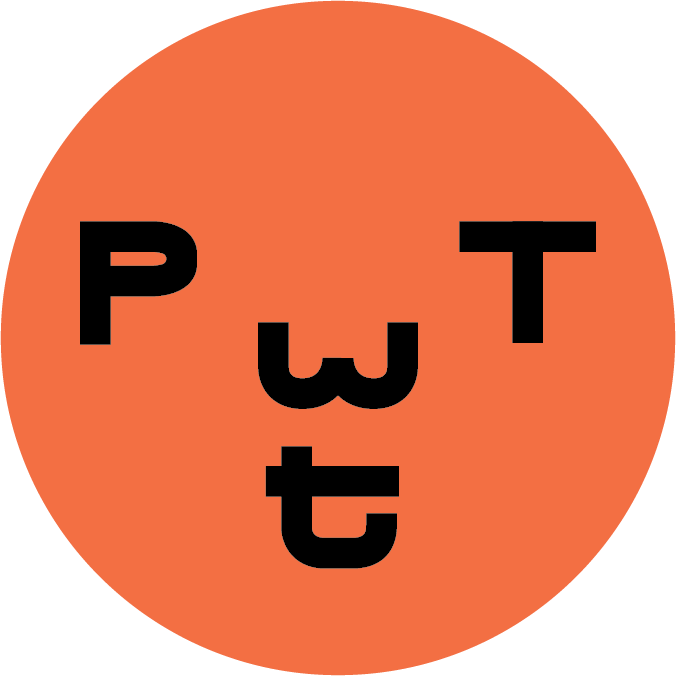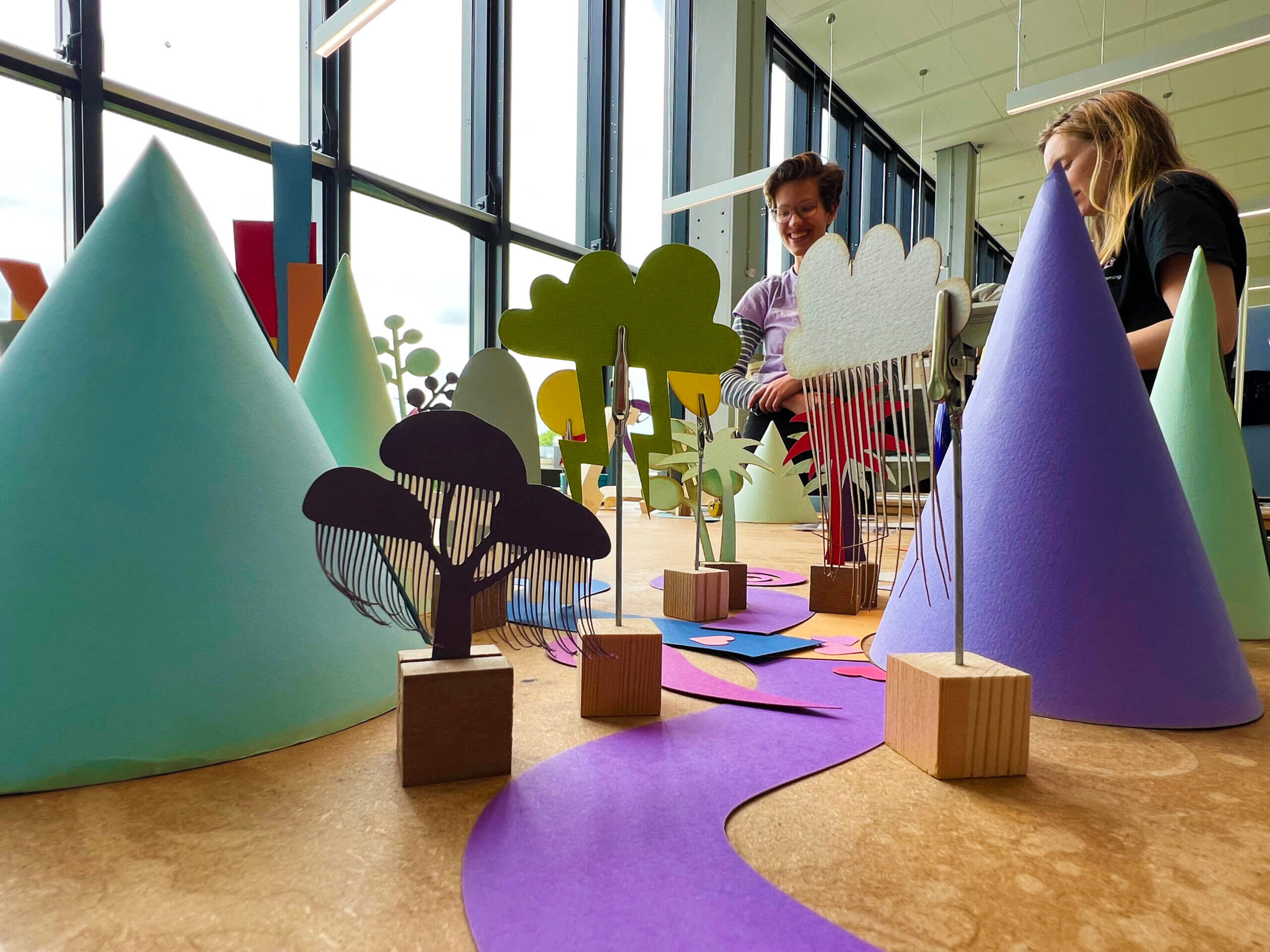
Future Landscapes
What (do you imagine) lies ahead of us?
A 45–60 minute activity for 1–20 people
Download these instructions as a PDF booklet
Header image: Example of part of a future landscape created in a workshop at TU Eindhoven with student participants exploring their own professional identities and visions for their careers.
Is this the activity for your group?
- 45–60 minute duration
- A facilitator is useful if this is the first time participants do the activity
- Number of people: 1–20 (the limit is the amount of materials and space needed)
- High setup
- Medium difficulty
- Medium imaginative load
- Medium trust required
Why play this?
- Collective Imagining (Exploring different imaginaries of future together)
- Surfacing worldviews (Understanding each other’s position(alitie)s and assumptions about desirable futures)
You might also find that Future Landscapes supports other purposes:
- Embracing Ambiguity (Imagining aspects of incomplete and ambiguous futures)
- Staying With The Trouble (Imagining consequences and issues in futures)
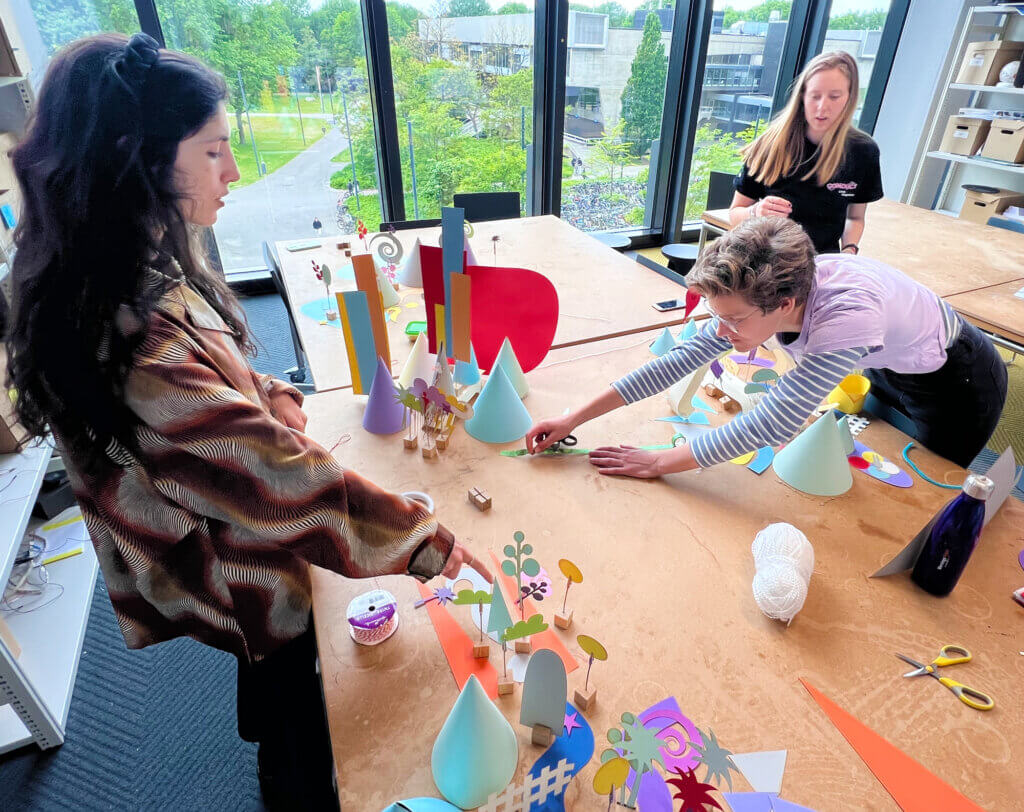
Components
Future Landscapes involves quite a significant degree of preparation in terms of the number and variety of card elements (although, once made, they can be used many times over). While it is possible to do a similar activity using toy houses/roads/trees/etc (e.g. from a model railway), Lego or Playmobil, we have found that the relatively abstract card landscape elements seem to act as more of a ‘blank (but not too blank) canvas’ for participants to construct their own metaphorical meanings than detailed model elements would do.
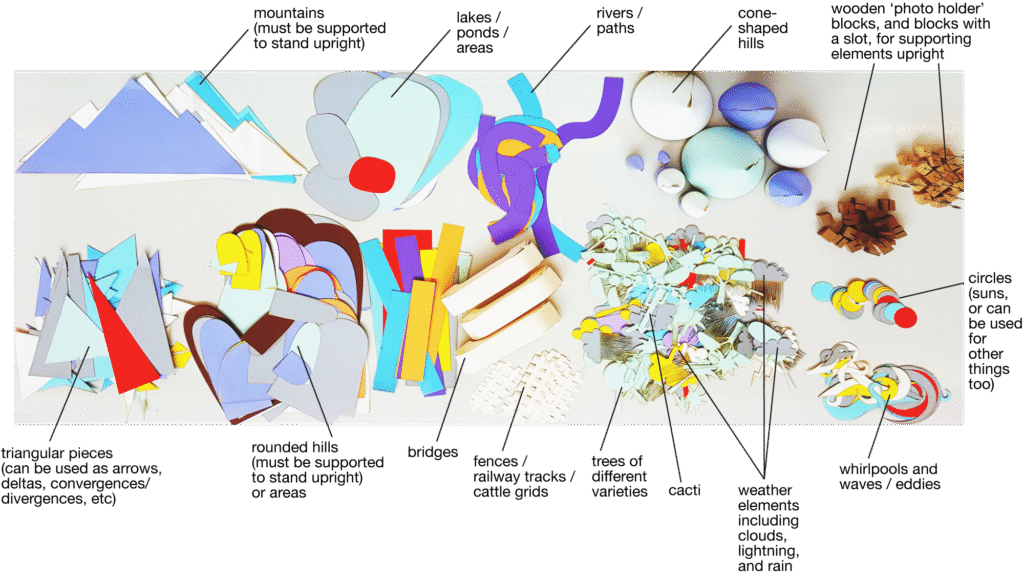
- Landscape elements such as hills, roads, bridges, fields, fences, and weather conditions. A non-exhaustive set is illustrated above. These elements can be laser-cut, blade-cut (e.g. using a Cricut), or cut by hand, ideally from 200–250 gsm card (stiff enough to stand up, where necessary, but flexible enough to be able to bend). Some workshops have used normal (coloured) paper but this is not ideal.
- The use of multiple colours (which are not necessarily ‘realistic’ for a landscape) may help more imaginative and speculative storytelling; we have usually chosen pastel shades with a few bolder colours to enable participants to use the colours also to have metaphorical meanings where it makes sense for them.
- There should be enough of the different elements available to participants that they can choose (and be inspired by) a whole range of different elements.
- Files to enable cutting of the elements are available: https://imaginari.es/future-landscapes
- Optional: figures of people—these have proved useful in some sessions, but some participants have commented that they focus the exercise too much on (individual) humans
- Optional: figures of icons such as hearts and stars—these have proved popular but potentially ‘break’ the metaphorical space of the landscape
- Optional: other materials such as (real) leaves or stones, which may enable particular metaphors relevant to a context to be incorporated by participants.
- Photo clips, wooden blocks, binder clips, and/or Blu Tack (poster buddies, etc). These are used to help some of the elements stand up or be raised above others.
- Large sheets or a roll of paper as a (writable) surface for the landscape to be built. Foamcore poster board can also be used to enable the landscape to be (carefully) moved, intact, after the workshop. Usually white paper is easiest to find, but brown kraft paper, or even black foamcore, can provide a more interesting background visually.
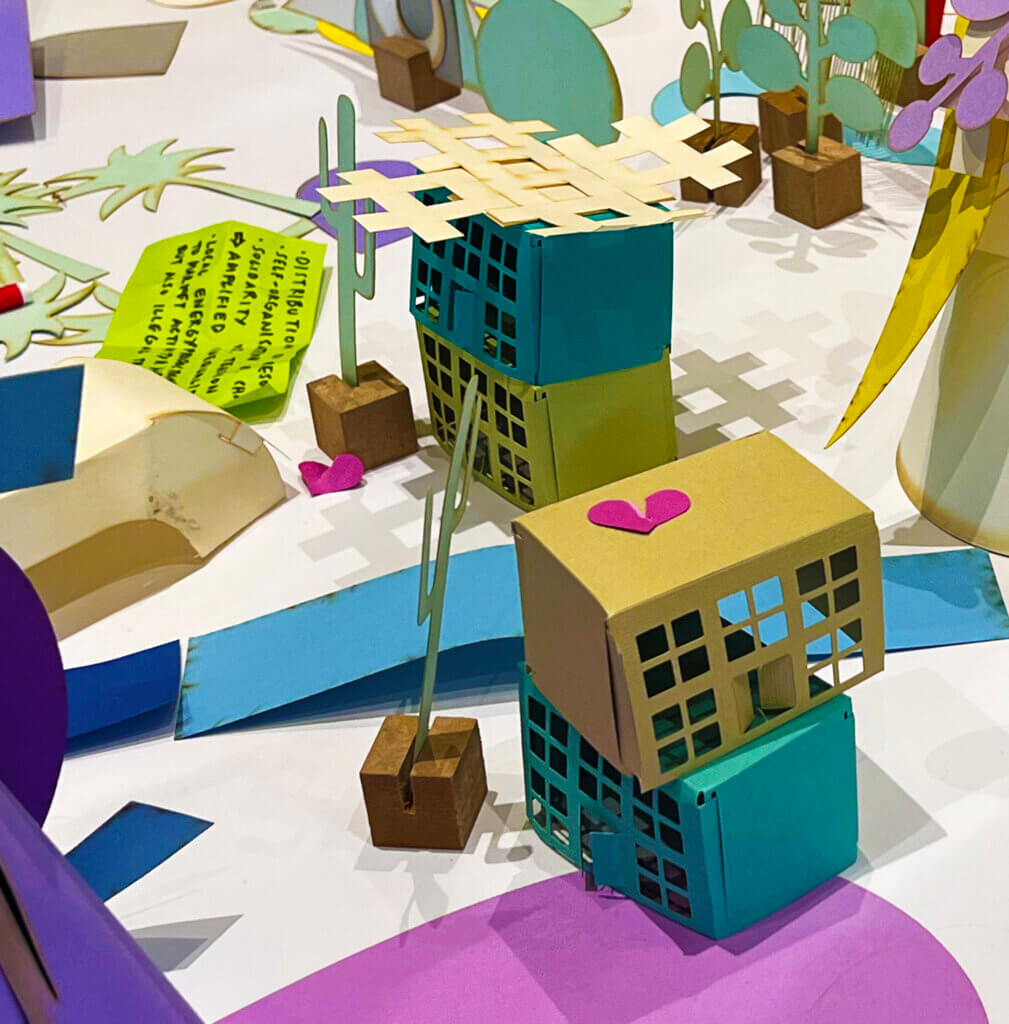
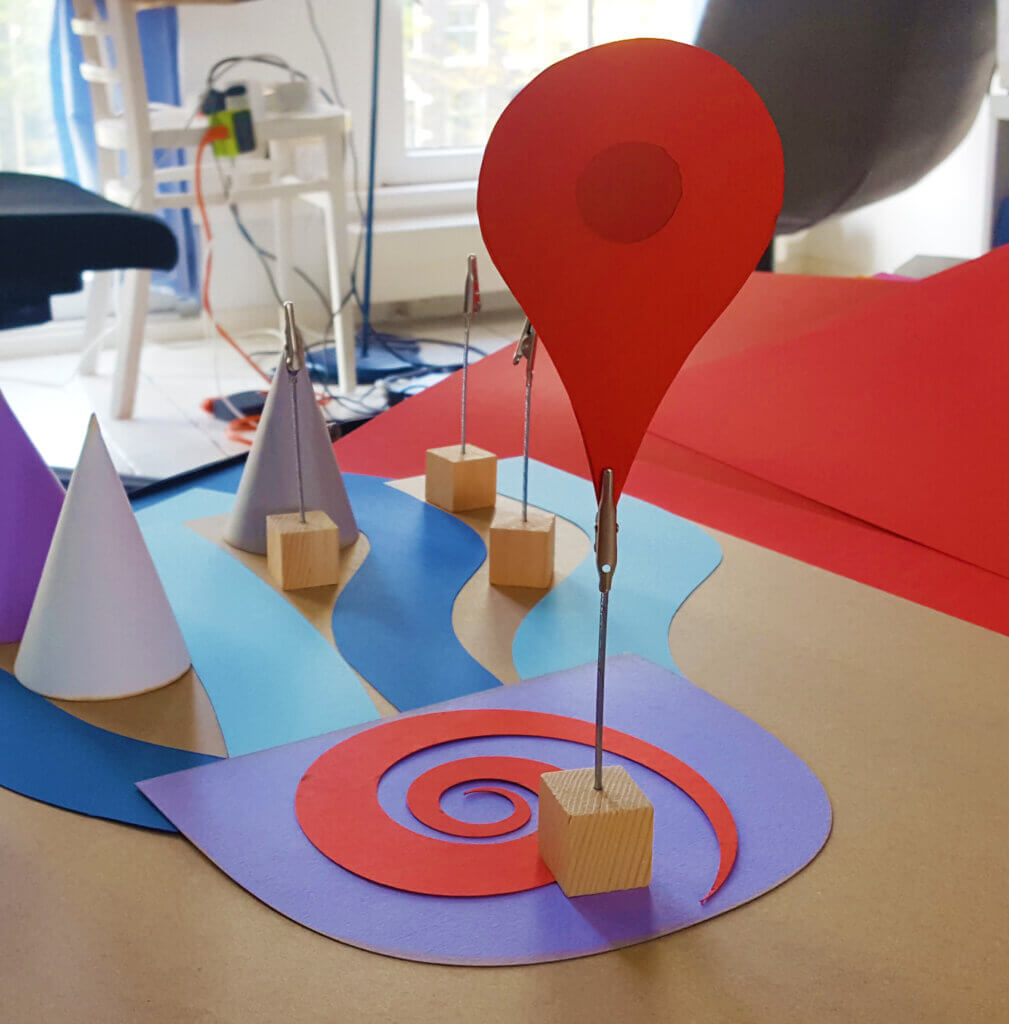
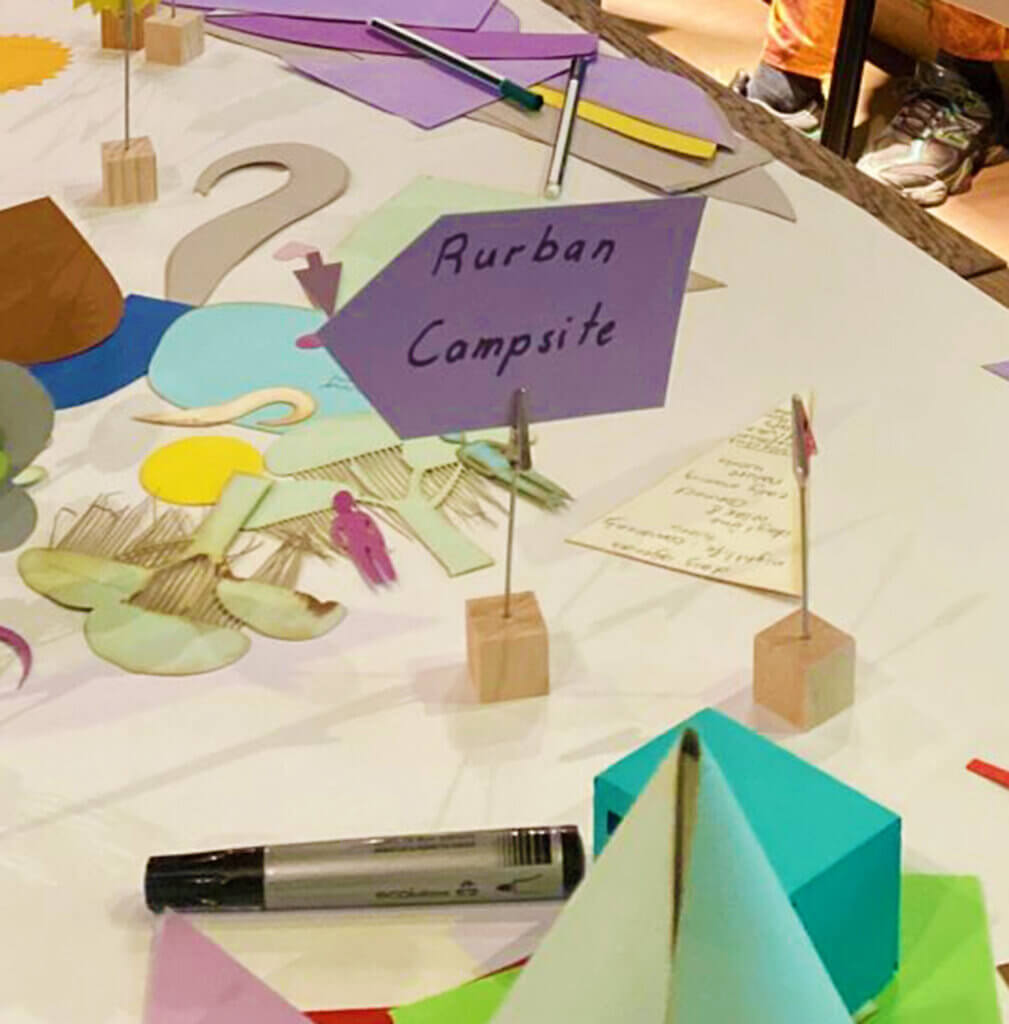
Background and objectives
Future Landscapes is a development of Mental Landscapes (Ricketts & Lockton, 2019), originally created as a way for students to visualise their career and education ‘journeys’, and developed further in contexts such as enabling ‘physicalisation’ of (imaginaries of) interdisciplinarity (Lockton et al, 2019, 2020), developing a professional identity and career vision (Khalandi et al, 2023), and expressing changing relationships with technology during the coronavirus pandemic (Merl et al, 2023).
Essentially the kit comprises a selection of card elements embodying metaphors of stylised landscapes and features within landscapes. The aim is to provide opportunities for participants to express and explore ways of visualising abstract concepts without prescribing a particular narrative format, although ‘journeys’ and ‘paths’ of various kinds have often resulted. In Future Landscapes, the emphasis is placed on building landscapes representing imagined possible futures (and sometimes pasts)—and choices/paths ahead—whether for particular collaborations, personal/group development, or to explore wider societal, environmental, or political contexts within which a project might take place.
Ricketts, D. and Lockton, D. (2019). Mental Landscapes: Externalizing Mental Models Through Metaphors. Interactions 26 (2), 86-90. https://doi.org/10.1145/3301653. Available at http://imaginari.es/publications/p86-ricketts.pdf
Lockton, D., Brawley, L. Aguirre Ulloa, M., Prindible, M., Forlano, L., Rygh, K., Fass, J., Herzog, K., Nissen, B. (2019). Tangible Thinking: Materializing how we imagine and understand interdisciplinary systems, experiences, and relationships. Workshop at RSD8: Relating Systems Thinking and Design Symposium, 17–19 October 2019, Chicago. Available at http://imaginari.es/tangible
Lockton, D., Forlano, L., Fass, J., Brawley, L. (2020). Thinking with Things: Landscapes, Connections and Performances as Modes of Building Shared Understanding. IEEE Computer Graphics & Applications, 40 (6), 38-50. https://doi.org/10.1109/MCG.2020.3027591. Available at https://imaginari.es/publications/IEEE2020.pdf
Khalandi, G., van Riet, C. M., Wijers, J. A. (2023). Landscape metaphors for bachelor design students’ identity and vision development. In I. Ordonez Pizarro, P. Sustersic, L. Buck, H. Grierson, & E. Bohemia (Eds.), Proceedings of the 25th International Conference on Engineering and Product Design Education: Responsible Innovation for Global Co-Habitation, E and PDE 2023 (421-426). Design Society. https://doi.org/10.35199/EPDE.2023.71
Merl, A., Bakker, L., Bremmers, N., van Gurp, J., Habraken, M., Lockton, D., Markopoulos, P. (2023). Material Metaphors: Method for physicalizing relations and experiences. Cumulus Antwerp 2023: Connectivity and Creativity in times of Conflict. https://library.oapen.org/bitstream/handle/20.500.12657/85903/110.pdf
Example: Use in education
A workshop in the first session of a course about design for future climate pathways.
A version of Future Landscapes was used for student groups (bachelor, master, and PhD, together) to get to know each other’s backgrounds (including surfacing worldviews) and collective imagining of ideas about the future, as a way into group projects. The questions asked were ‘What does your past and future look like as a landscape? Where are we going?’
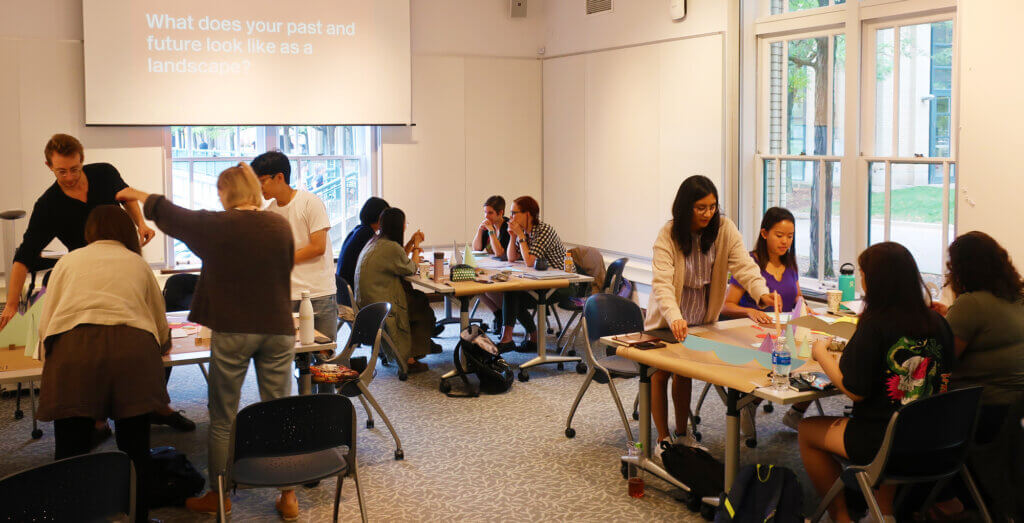
Four groups of 3–5 students each had tables with brown paper on, and a selection of landscape elements, clips, and wooden blocks. Further elements were on a table at the side of the room, and participants could come to get more / swap items when they wanted to.
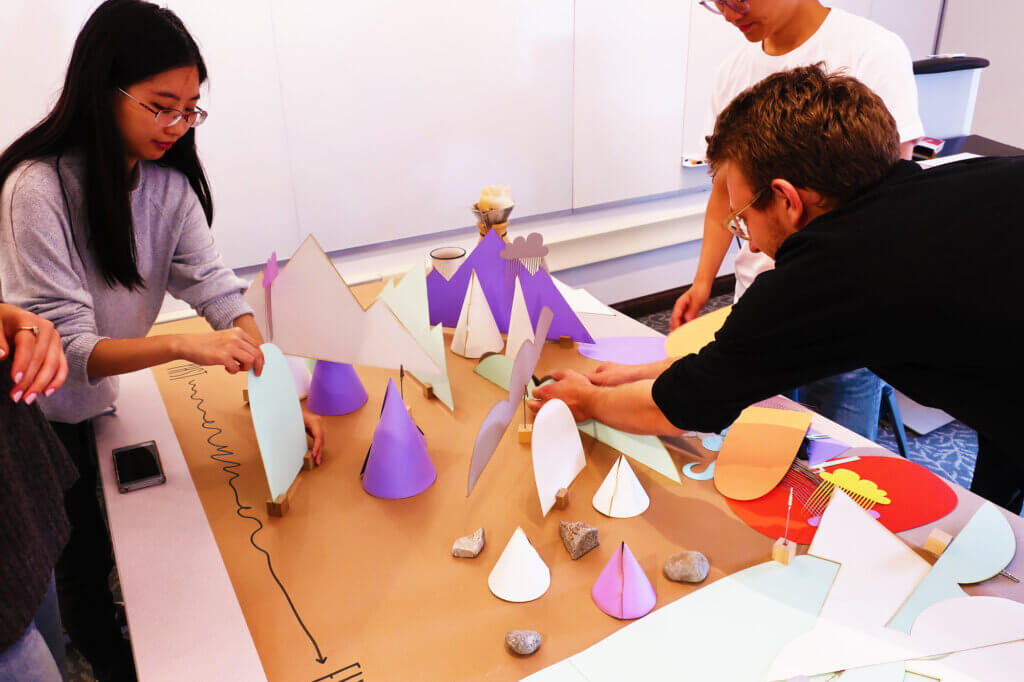
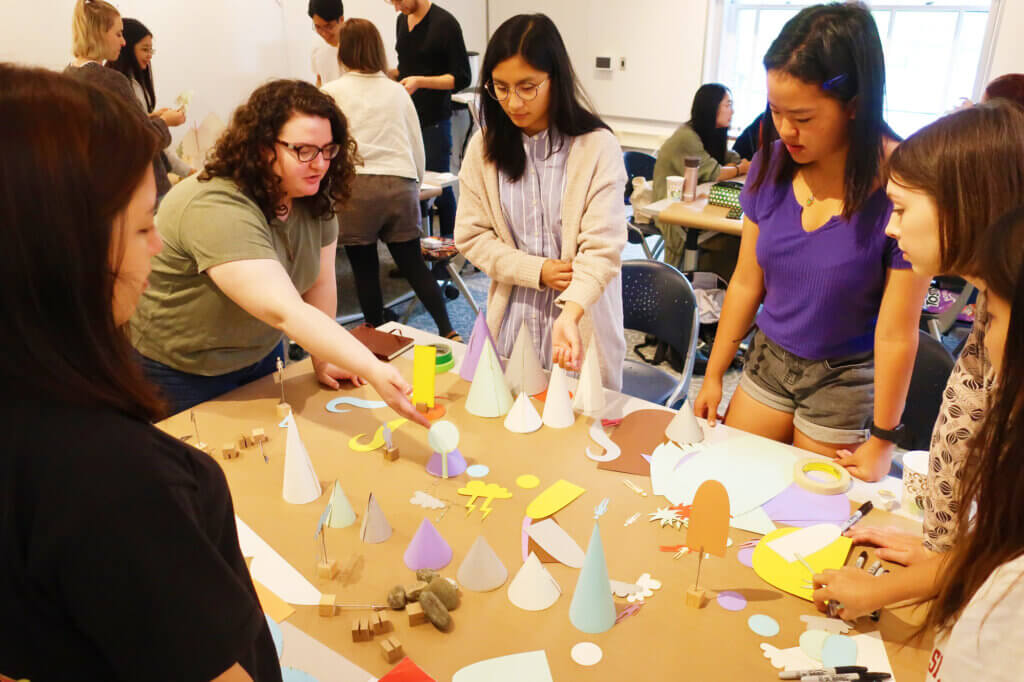
We introduced the idea to groups that they might prefer to start with each person building their own parts of a landscape individually, and then after 10 minutes or so, working together to connect these to create a larger landscape. Two groups chose this approach while two groups chose to work all together right from the start.
We emphasised that “Your discussion with each other is as important as the outcome”.
Sharing and discussion (30 mins)
We gathered around each table, and the group told everyone the story of their landscape, and others asked questions and looked at the landscapes. Some of the landscapes are shown here.
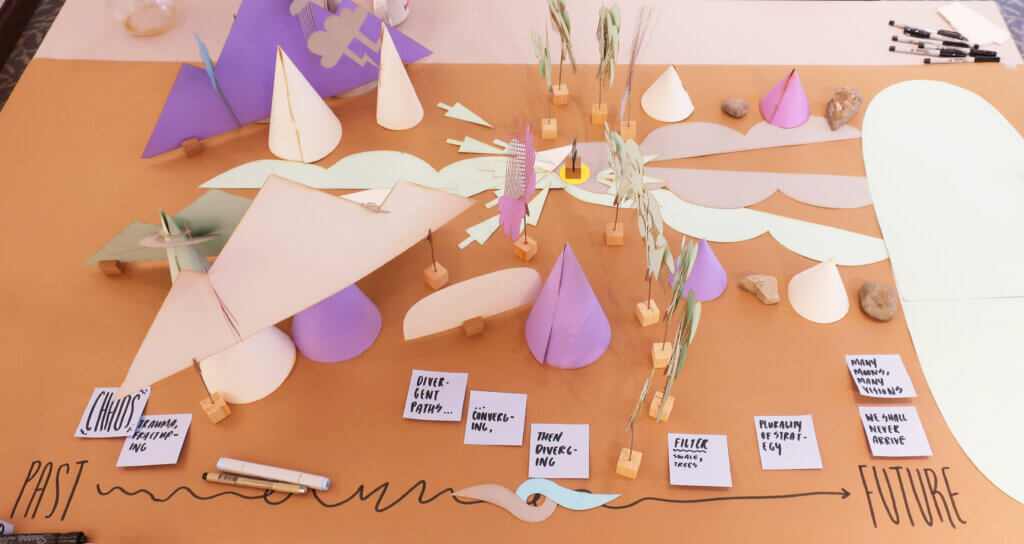
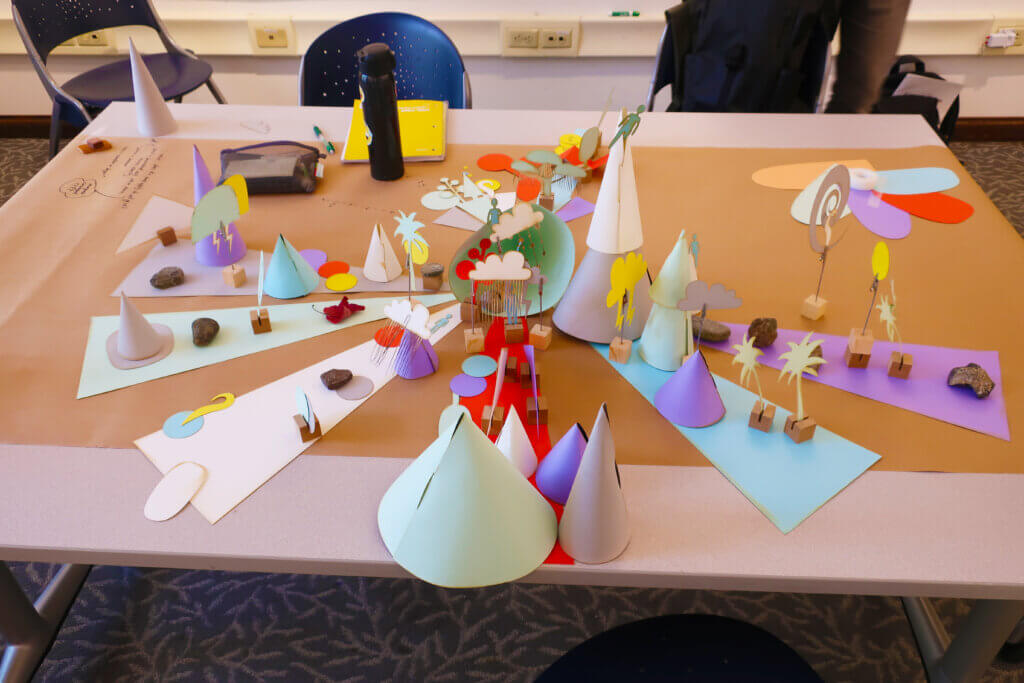
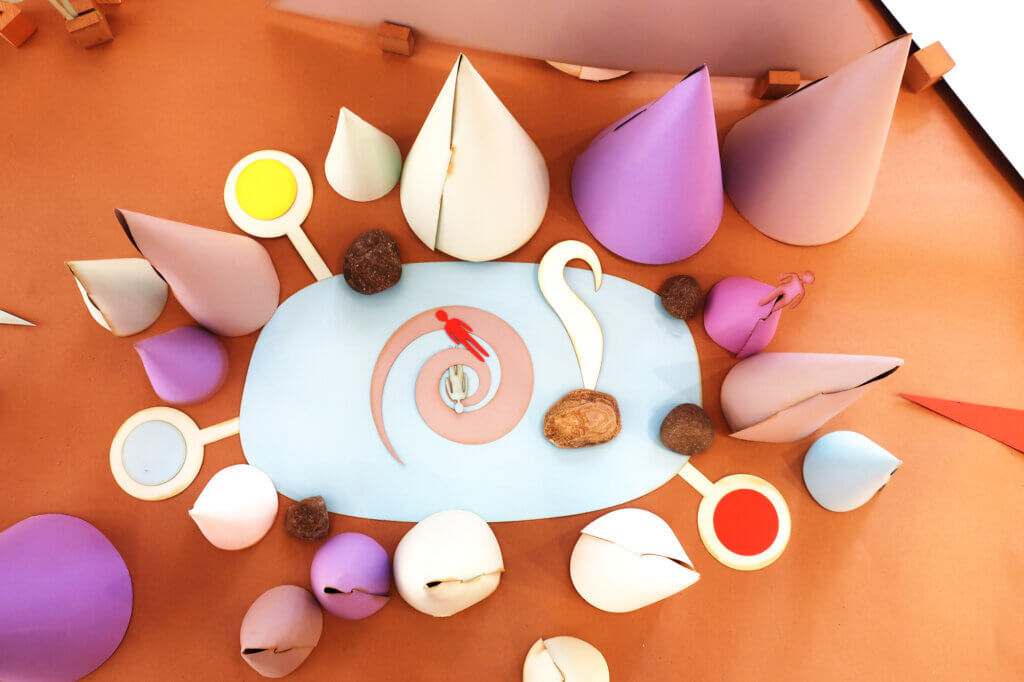
Meta-questions (on a slide) that we kept in mind included:
- What worked? What didn’t work? Why?
- Did you already have some degree of ‘landscape metaphor’ in mind about the future?
- To what extent did the ‘designed’ elements help / hinder / affect how you thought about the issue?
- In your group, did the process have value for you to come to understand each other, or for revealing disagreements?
- Did it help with your own individual reflection?
- And did it help you generate new ideas about the future?
Download the instruction booklet
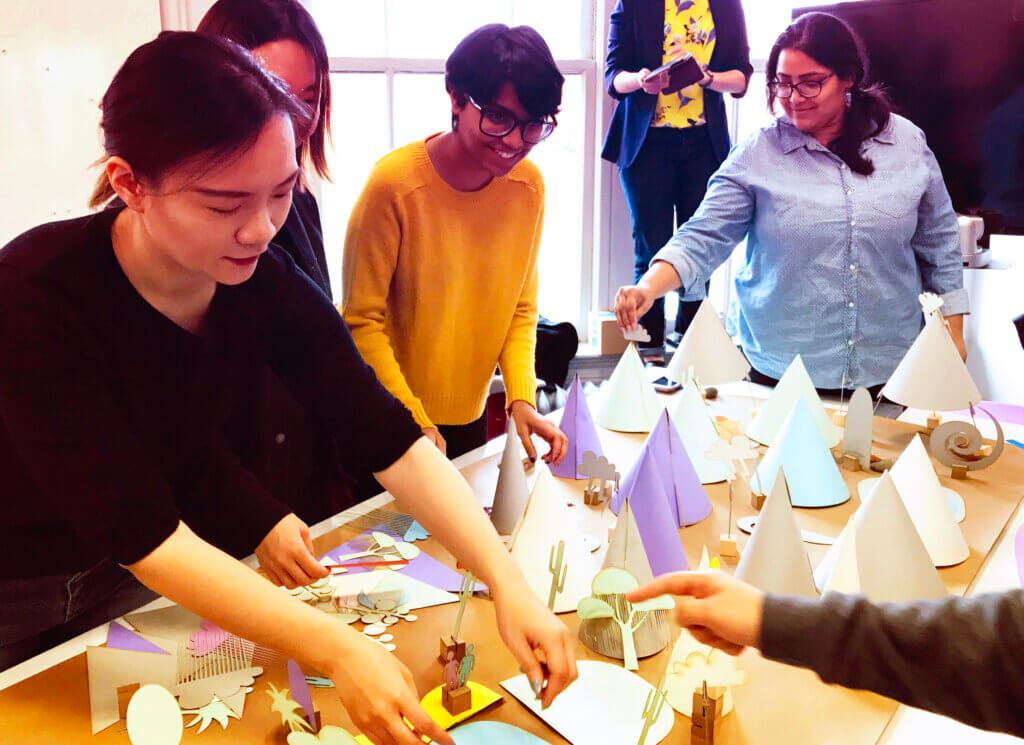
The original Mental Landscapes kit from which Future Landscapes has evolved was created by Delanie Ricketts and Dan Lockton, developed further with contributions from Tammar Zea-Wolfson, Matt Prindible, Lisa Brawley, John Fass, Laura Forlano, Manuela Aguirre Ulloa, Anna Merl, Lucas Bakker, Nina Bremmers, Jules van Gurp, Marloes Habraken, Gizing Khalandi, Katrien van Riet, Jelle Wijers, and Julieta Matos Castaño.
